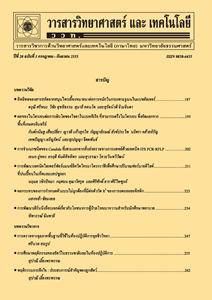Effect of Hydrogen Peroxide on Quality of Squid (Loligo spp.)
Main Article Content
Abstract
Squid has a unique flavor and texture but its flesh is highly perishable. Therefore, using hydrogen peroxide (H2O2) to preserve the squid quality was investigated. The first study, raw squids were washed with tap water (RH00) and various concentrations of H2O2 solution, including 0.0035 % (RH35), 0.0055 % (RH55), and 0.0075 % (RH75), compared with the control as no washed sample (RN00). The second study, the squids from the first study were boiled until cooked, then washed with tap water (CH00) and H2O2 solution 0.0035 % (CH35), 0.0055 % (CH55) and 0.0075 % (CH75) before storing at 4±1 ºC. Microbiological quality of both raw and cooked squids were investigated. Physical and sensory qualities were evaluated only cooked squids. RH75 and CH75 showed the least total microbial counts (TPC) (p ≤ 0.05), and pathogenic microbes were not detected for all samples. CH35 showed the lowest weight loss and the highest in shear strength and sensory quality (p ≤ 0.05). The shelf life of the cooked squid CH75 was longer than 20 days, while those of CH55, CH35, and CH00 were 20, 20 and 16 days, respectively. The shelf life of the raw squid RH75, RH55, RH35, RC00 and RN00 were 12, 8, 6, 4 and 2 days, respectively (TPC standard for cooked seafood is less than 6 log CFU/g). Washing squid with 0.0075 % H2O2 was helpful for preserving of microbiological quality but causing protein degradation, which affected physical and sensory qualities. Besides, washing squid with 0.0035 % H2O2 was effective on preserving of physical and sensory qualities.
Article Details
References
Ministry of Agriculture and Cooperatives, 2018, Squid Export Statistics and Products Included, Available Source: http://www.oae.go.th, July 14, 2019. (in Thai)
Ministry of Public Health, 2019, Chemicals Used to Inhibit Microorganisms in the Aquatic Industry, Available Source: http://www.fda.moph.go.th/sites/food/law1/sum_law.pdf, July 14, 2019. (in Thai)
Naruemon, M., 2007, Natural preserva tives: Aromatherapy, Food 37(2): 127-132. (in Thai)
Alvarez, O.M., Borderías, J. and Guillén, M.C.G., 2005, Use of hydrogen peroxide and carbonate/bicarbonate buffer for soaking of bacalao (salted cod), Eur. Food Res. Technol. 221: 226-231.
Nagarajan, M., Benjakul, S., Prodpran, T., Songtipya, P. and Nuthong, P., 2013, Film forming ability of gelatins from splendid squid (Loligo formosana) skin bleached with hydrogen peroxide, Food Chem. 138: 1101-1108.
AOAC, 1994, Official method 991.14, Coliform and Escherichia coli count in foods, J. AOAC 74: 1-635.
AOAC, 1995, Official Methods of Analysis, 16th Ed., Association of Official Analytical Chemist, Arlington, VA.
Ministry of Public Health, 2013, Food Standards for Pathogenic Microorganisms, Available Source: http://elib.fda.moph.go.th/fulltext2/กฎหมาย/กองควบคุมอาหาร/ประกาศกระทรวงสาธารณสุข/56/364.pdf, July 14, 2019. (in Thai)
Teerawut, S., Sangsriraung, K. and Kwan-On, P., 2016, Effect of modified atmosphere packaging on the physical and sensory properties of smoked oyster (Saccostrea cucullata) during refrigerated storage, NU. Int. J. Sc. 13(1): 26-36.
Metropolitan Waterworks Authority, 2018, Water Quality Standard, Available Source: https://www.mwa.co.th/ewt_dl_ link.php?nid=33082, March 1, 2020. (in Thai)
Fraser, O. and Sumar, S., 1998, Compositio nal changes and spoilage in fish-an introduction, Nutr. Food Sci. 98: 275-279.
Krishnan, J., Berry. J., Fey, G. and Wagener, S., 2006, Vaporized hydrogen peroxide-based biocontamination of a high-containment laboratory under negative pressure, Appl. Biosaf. 11: 74-80.
Ferreira, S., Landeiro, M., Rogeria, A. and Ana, N., 2007, Hazards and critical control points in Brazilian seafood dish preparation, Food Control 18: 513-520.
Benjakul, S., 2013, Chemistry and Aquatic Quality, Odean Store, Bangkok. (in Thai)
Leungsakul, S., 1998, Food Microbiology, Chai Charoen, Bangkok. (in Thai)
Srinivasan, S. and Hultin, H.O., 1995, Hydroxyl radical modification of fish muscle proteins, J. Food Biochem. 18: 405-425.
Young, J.W., Chandler, R.F., Snow, C.C., Robinette, K.M., Zehner, G.F. and Lofberg, M.S., 1983, Anthropometric and Mass Distribution Characteristics of the Adults Female, Technical Report FA-AM-83-16, FAA Civil Aeromedical Institute, Oklaoma.
Krishnan, J., Berry, J., Fey, G. and Wagener, S., 2006, Vaporized hydrogen peroxide-based biocontamination of a high-containment laboratory under negative pressure, Appl. Biosaf. 11: 74-80.
Kong, S. and Davison, A.J., 1980, The role of interactions between O2, H2O2, OH, e- and O2- in free radical damage to biological systems, Arch. Biochem. Biophys. 204: 18-29.
Pedchoo, S., Chaikittipor, C., Pruktharath ikul, V., Luksamijarulkul, P., Singhakajen, V. and Kolladarungkri, T., 2014, Evaluation of the efficacy of Hydrogen peroxide vapour for operating room air microbial decontamination, Available Source: http: //www.vali-tech.net/home/article-read. php?ArticleId=7, August 18, 2019
Sungsri-in, R., 2010, Development of Pink Color of Squid and the Effect of Chemical Treatment on Physico-chemical Changes of Squid During Frozen Storage, Master Thesis, Prince of Songkla University, Songkla, 116 p.
Khunsungnoen, N., 2003, Quality Change of Tilapia Fillets Stored under Modified Atmosphere, Songkla, Suranaree University of Technology, Nakhon Ratchasima, 85 p. (in Thai)
Teerawut, S. and Kwan-On, 2014, Shelf-life Extension of Cooked Green Mussel Using Sodium Alginate-based Edible Coating Containing Different Antioxidants and Modified Atmosphere Packaging: Effect of Sodium Alginate Based Edible Coating Containing Different Antioxidants, Annual Report 2014, National Research Council of Thailand, Burapha University, Chonburi. (in Thai)
Nagarajan, M., Benjakul, S., Prodpran, T. and Songtipya, P., 2013, Effects of bleaching on characteristics and gelling property of gelatin from splendid squid (Loligo formosana) skin, Food Hydrocoll. 32: 447-452.


